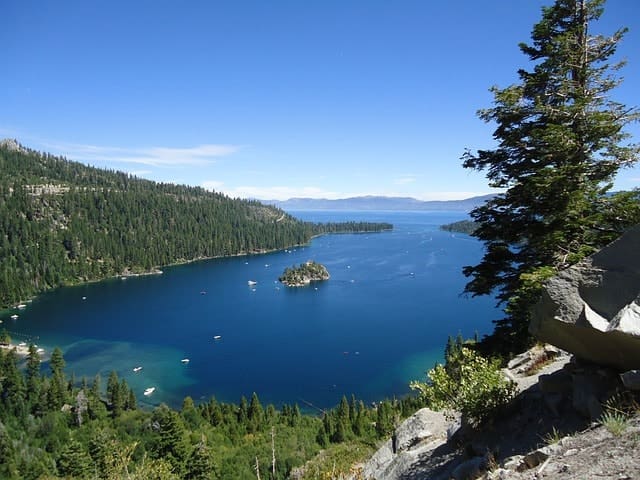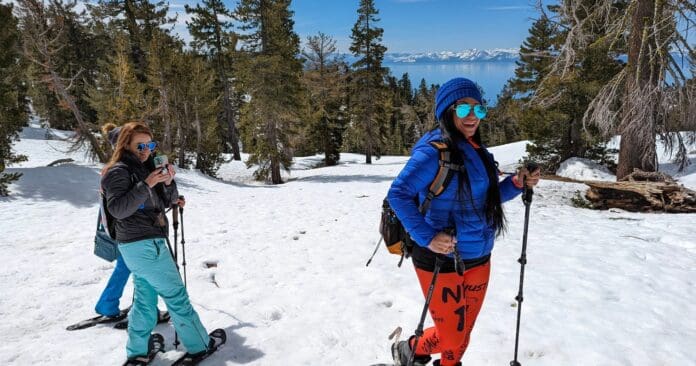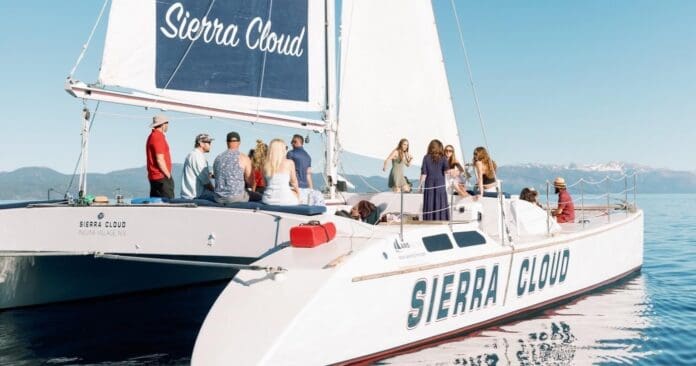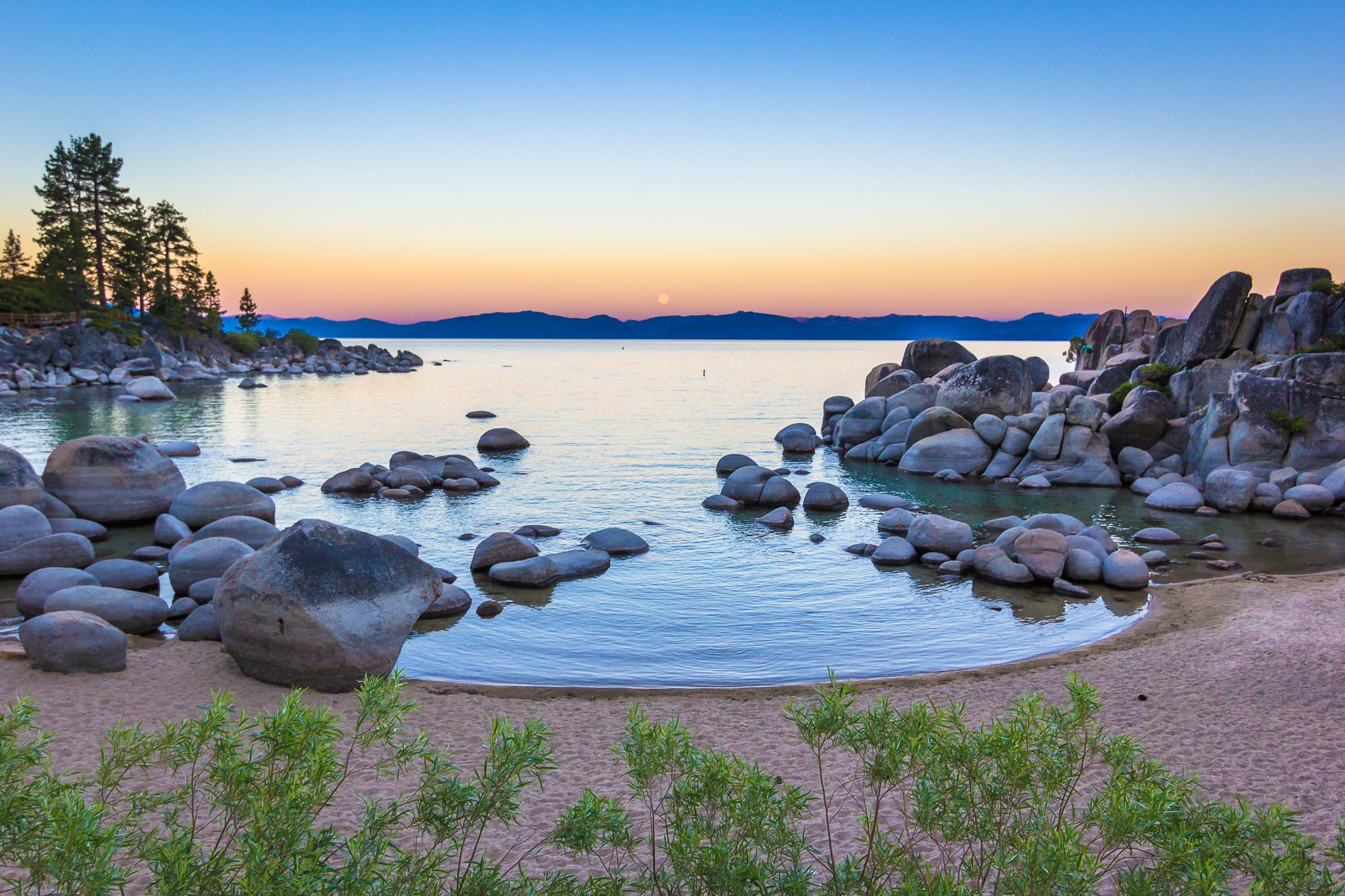
If you haven’t already been to Lake Tahoe, chances are that you’ve heard about it from a friend or had it pop up on your Instagram feed. It’s really no surprise—with epic views, year-round outdoor recreation and a vast collection of perfect views and photo ops, Lake Tahoe makes an easy add to anyone’s travel bucket list.
When it comes to Lake Tahoe, location is everything. Not just knowing where Lake Tahoe is, but getting a good understanding of the whole Lake Tahoe basin.
You’ve probably got questions like—What’s the difference (and distance!) between North Lake Tahoe and South Lake Tahoe? What state is Lake Tahoe in? How far from San Francisco is Lake Tahoe? And most importantly, should I opt for a quiet cabin on the west shore, or camp at Zephyr Cove?
Whether you’ve been wanderlusting after Tahoe for a while or it’s just made its way onto your radar, we’re here to help you nail down the who, what, when and where of everyone’s favorite mountain destination.
Where is Lake Tahoe?
Lake Tahoe is located in the Sierra Nevada mountain range, along the California-Nevada border. Sitting squarely on the border between the two states, about ⅔ of the lake’s shoreline falls in California with the rest in Nevada.
That’s right! When you’re boating on the lake, you’ll most likely be moving across the California and Nevada border more than once.
Lake Tahoe is about 200 miles northeast of San Francisco, 110 miles east of Sacramento and 40 miles south of Reno, NV. There are two state lines that you can cross over while visiting. One is in Crystal Bay, in North Lake Tahoe and the other is in South Lake Tahoe.
That means the western shore of Lake Tahoe, and the state parks that call it home—like Emerald Bay State Park, D.L. Bliss State Park and Ed Z’berg Sugar Pine Point State Park—are all in California.
On the eastern shore of Lake Tahoe, you’ll find the Nevada state parks, the highlight of which being the highly photographed, Sand Harbor State Park.
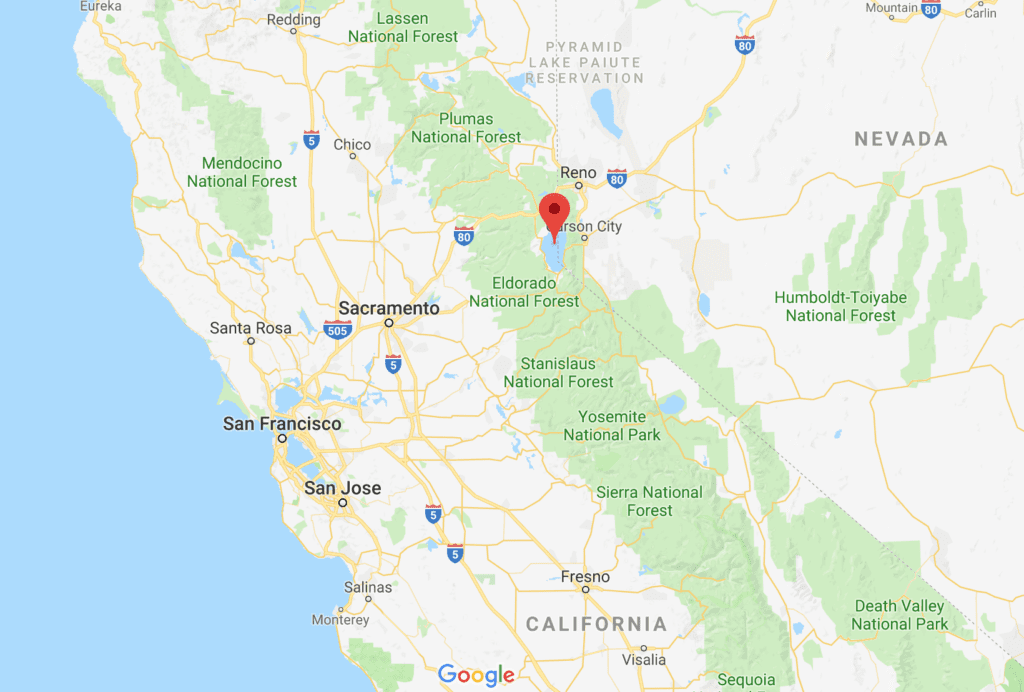
Is Lake Tahoe man made?
Lake Tahoe is not man made—not even a little! Lake Tahoe was formed 25 million years ago, as the result of geologic block faulting. As uplifted blocks created the surrounding mountain ranges, down-dropped blocks created the Lake Tahoe basin.
Over millions of years, a mix of glacial & volcanic activity shaped the basin until it became the modern lake that we know and love today.
Smaller alpine lakes that surround Lake Tahoe, such as Emerald Bay, Cascade Lake, Fallen Leaf Lake and the Angora Lakes are all similar, smaller relics from the same time period.
What is Lake Tahoe’s elevation?
Lake Tahoe sits at 6,225 feet in elevation. Sitting this high up, Lake Tahoe is a true alpine lake, surrounded on all sides by the Sierra Nevada mountain range.
What is Lake Tahoe known for?
Our instincts tell us the answer is, “everything!” but there’s a few more textbook answers to this question. Lake Tahoe is the largest alpine lake in North America. By volume, only the five Great Lakes (which are not alpine lakes) in the northeastern United States are larger.
Lake Tahoe is also known for both its immense clarity and purity. Both of which contribute to its iconic blue color! The purity of Lake Tahoe’s water is exceptional, often compared to commercially distilled water, which is known for its high purity at 99.998%.
The altitude and protection of the Sierra Nevadas lend to crisp, clear mountain air and water, both of which contribute to the lake’s clarity. The average depth of Lake Tahoe is 1,000 feet, which also plays a significant role in maintaining its cool water temperatures and environmental stability.
Will Lake Tahoe always be so clean and clear?
Despite appearing as pristine as ever to the naked eye, human activities have impacted the lake’s clarity, resulting in a loss of about one-third of its clarity since 1968. Fine particles and nitrogen from atmospheric fallout and development-impacted watersheds are major contributors to this decline.
To combat these issues, organizations like Keep Tahoe Blue and Tahoe Regional Planning Agency are actively working on conservation and education efforts to protect the lake’s water quality and clarity. These efforts aim to preserve Lake Tahoe’s natural beauty and recreational opportunities for future generations, ensuring that it remains a pristine and cherished destination.
Visitors to the Lake Tahoe area can also contribute to conservation efforts by respecting the natural environment, minimizing their impact on the ecosystem, and supporting local businesses and organizations that prioritize sustainability. (Seriously, do your part, please.)
By working together, we can ensure that Lake Tahoe stays as pure and beautiful as it is today.
How deep is Lake Tahoe?
At its deepest point, Lake Tahoe is 1,645 feet deep. To help visualize exactly how deep that is, if you set the Empire State building at the lake’s lowest point, it would still be 200’ below the surface of the lake!
In the United States, its the second deepest lake, falling short only to Crater Lake in Oregon. Being so deep, Lake Tahoe never freezes.
What temperature is the water in Lake Tahoe?
On the surface level, Lake Tahoe ranges from 40 degrees to 70 degrees, depending on the season. Come at the end of summer, and the water will most likely be in the high 60s or above! In the winter and springtime, when nighttime temperatures are freezing, it’ll be closer to that 40 degree mark.
However, once you get below 700 feet, the temperature of the water stays at a static 39 degrees.
The lake surface plays a crucial role in affecting the water temperature, as it experiences significant evaporation and interacts with light, contributing to the lake’s overall thermal dynamics. Science.
What is the historical significance of Lake Tahoe?
Lake Tahoe’s history extends back to 2 million years ago, when the surrounding mountains began to rise and the valley bottom began to sink, creating a basin. Over time—lots of time—the basin filled with water, forming the ancestral Lake Tahoe. Along the same timeline, the escaping water carved through volcanic rock, establishing the lake’s outlet, the Truckee River.
The Washoe Native Americans, who have lived in the region for thousands of years, call the lake “da ow a ga,” meaning “edge of the lake.” Before the lake drew the attention of silver miners and early pioneers seeking natural resources, the Washoe tribe lived in the present-day Lake Tahoe area, with the lake as the centerpiece of their lifestyles.
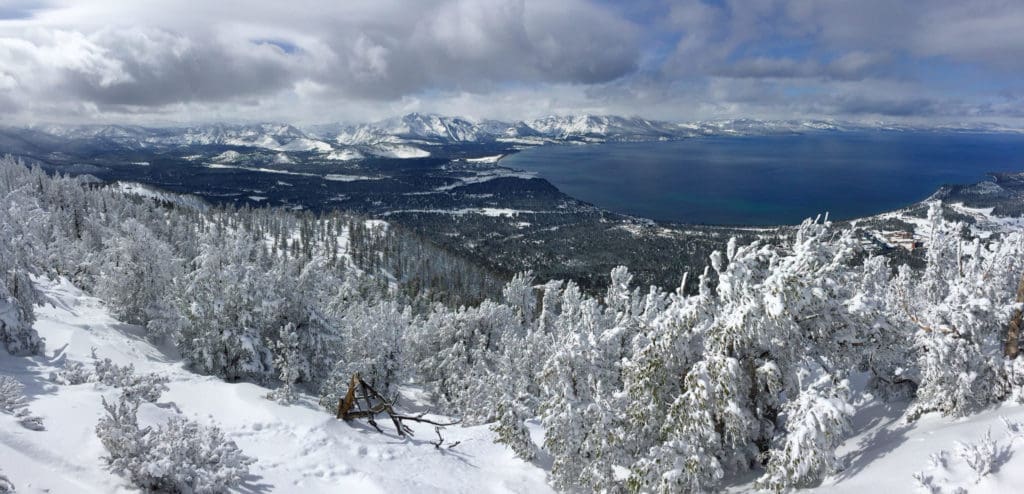
Why visit Lake Tahoe?
There’s truly something here for everyone. From an outdoor recreation perspective, Lake Tahoe is as perfect as it gets. It’s a natural paradise, with activities in Lake Tahoe, countless trails, water-based adventures, ski mountains and beaches that cater to any taste.
Restaurants, bars and happy hours abound. You’ll find everything from dive bars and order-at-the-counter burger joints, to classic steakhouses and craft beer gardens. You can hike, bike and boat by day, then relax by the fire or get lucky at the casinos by night. Great for families, couples, bachelor parties and beyond, there’s just no going wrong with a trip to Lake Tahoe!
Whether you’re looking for a romantic, upscale escape with spa days and happy hour boat cruises or family-friendly camping, you’ll find it all.
When’s the best time of year to visit Lake Tahoe?
With four full seasons of recreation, the best time of year to visit Lake Tahoe really depends on what you like to do! No matter the season, Lake Tahoe offers a variety of outdoor adventure activities.
In the summer, you can enjoy hiking, biking, boating, and exploring the 72 miles of beautiful shoreline. In the winter, the area transforms into a winter wonderland with skiing, sledding, snowmobiling, and snowshoeing. Spring and fall bring opportunities for enjoying the blooming flowers and vibrant fall colors, making every visit an outdoor adventure.
During the summer months of June, July and August, Lake Tahoe is drenched in sunshine, and stays about 80 degrees Fahrenheit. People flock to the area to enjoy hiking, biking, boating and enjoy every last inch of Lake Tahoe’s 72-miles of beautiful shoreline. The beaches fill with families, the lake hosts boats, paddle boards and kayaks, and the campgrounds overflow with summer vacationers.
Lake Tahoe is an incredibly popular destination for the Fourth of July, with an annual fireworks show over the lake. In fact, the firework display on Lake Tahoe’s south shore is consistently rated as one of the top 10 fireworks displays in the nation. You’ll also find summer concerts and events every single weekend.
In the winter, temperatures drop to freezing, transforming Tahoe into a full-blown winter wonderland. The area boasts world-class mountains with over 10 ski resorts, including Heavenly Mountain Resort in South Lake Tahoe and Palisades Tahoe, just outside of Tahoe City in north Lake Tahoe. Wintertime favorites, like sledding, snowmobiling, ice skating and snowshoeing are found everywhere in the Lake Tahoe basin.
Although the winter months are cold, Tahoe has over 300 days of sunshine a year, making for plenty of perfect, crisp, bluebird days.
Spring and Fall make up the shoulder seasons in Tahoe, although locals will argue these are some of the best times to visit. Temperatures hover in the sweet spot, the crowds die down and the surrounding forests and meadows explode with spring flowers or fall colors.
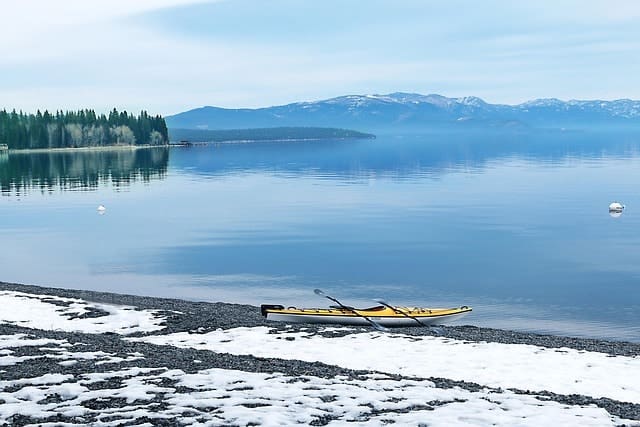
Where should I stay around Lake Tahoe?
Although South Lake Tahoe is the most populated and visited region in the area, there’s dozens of unique communities to discover in the Lake Tahoe region.
On the north shore, Incline Village, Kings Beach, Crystal Bay and Tahoe Vista hug the lakefront, while popular mountain towns like Truckee and Olympic Valley are also known for year-round tourism. Diamond Peak, a premier ski resort, offers breathtaking views of Lake Tahoe and is a popular destination for skiiers. Olympic Valley, with its proximity to Tahoe City, is home to Palisades Tahoe—one of the area’s most well-known and loved ski resorts.
North Lake Tahoe is closest area in the Tahoe basin to downtown Reno and the Reno area. Both California and Nevada shoreline can be found on the north shore.
On the west shore, you’ll find Tahoe City, Meeks Bay, Tahoma and Homewood. Incredibly beautiful and popular with families, there’s great beaches, hikes, campgrounds and the Homewood ski resort here. This shoreline is all apart of California.
The south shore is home to South Lake Tahoe, Stateline, Meyers and Emerald Bay. A busy but beautiful zone, the south shore is known for its open, sandy beaches and an exciting blend of casinos, restaurants and bars. Major ski resorts here included Heavenly Mountain Resort, Kirkwood Ski Resort and Sierra At Tahoe.
Both California and Nevada shoreline can be found in South Lake Tahoe.
Traveling to the East Shore, you’ll find some of the lake’s most beloved beaches and coves, like Sand Harbor, Zephyr Cove and Secret Beach. While this edge of the lake has some of the most picturesque places to paddle, swim and boat, there are the least amount of accommodation options here outside of house rental services like AirBnb. The east shore of Lake Tahoe is entirely on the Nevada side.
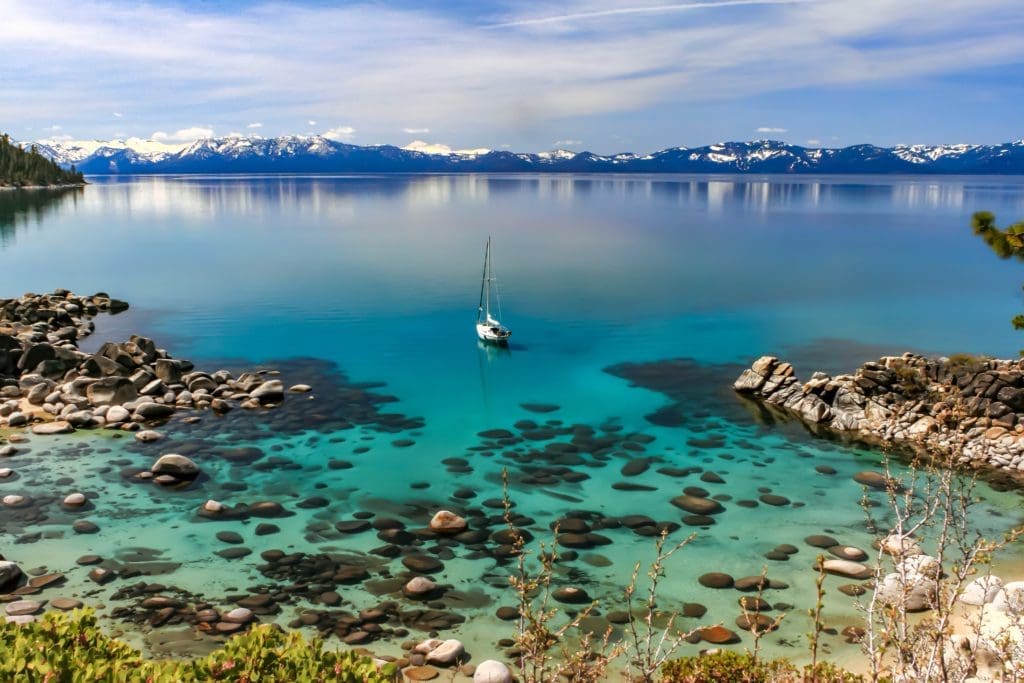
What is north Lake Tahoe like?
North Lake Tahoe and South Lake Tahoe each offer their own unique charm and experiences. North Lake Tahoe, often referred to as Tahoe North, is known for its serene and laid-back atmosphere. This region includes quaint towns like Incline Village, Tahoe City, Kings Beach, Carnelian Bay, Crystal Bay, and Tahoe Vista.
These small communities provide a cozy, welcoming feel, perfect for those looking to escape the hustle and bustle. Outdoor enthusiasts will find plenty to do, from skiing and hiking to biking and water sports.
This side of the lake is closest to area’s like Reno (which has a fantastic airport!), Virginia City and the ever-loved mountain town of Truckee.
What is South Lake Tahoe like?
On the other hand, South Lake Tahoe, is the largest city in the area, bustling with activity and excitement. With a permanent population of just over 21,000, South Lake Tahoe offers all the amenities of a larger city. The downtown area is a major draw, featuring four casino resorts on the Nevada side and the lively Heavenly Village on the California side.
That said, South Lake Tahoe hosts a majority of the basin’s local, full-time residents and is an extremely family-friendly location. Lots of concerts, events, farmers markets and beyond take place in this area.
Both regions are a haven for outdoor adventures, making them must-visit spots for anyone planning a trip to Lake Tahoe.
What are some can’t miss sights around Lake Tahoe?
We promise, you can’t go wrong. Every inch of Lake Tahoe’s shoreline is magical. But there are two places in particular that are just unlike anywhere else on Earth.
Emerald Bay, located on the southwest shore of Lake Tahoe, is the lake’s most distinctive bay. With mountains towering over all but the mouth of the bay, and the lake’s only island—Fannette Island—in the center, it’s truly a remarkable sight.
Also home to Vikingsholm, a 19th-century castle that visitors can reach via a scenic hike, and the Fannette Island teahouse, there’s a bit of history to be uncovered with a visit to Emerald Bay. Popular for boating and swimming, with kayak and stand up paddleboard rentals available on-site, this is one of the most-loved areas in all of the Tahoe basin.
But perhaps the most popular spot in all of Lake Tahoe is Sand Harbor State Park, located on the north side or Nevada side of the lake. That iconic photo of Lake Tahoe that you’ve seen time and time again? With the crystal clear waters, smooth, rounded boulders and forested shoreline? That’s the stunning, the beautiful, the iconic, the all-time, Sand Harbor State Park.
It’s absolutely gorgeous. And everyone knows it. You’ll need a reservation to visit over the summer, or you can take the Tahoe East Shore Trail out of Incline Village to access it by foot or bike. If you can, this spot is absolutely worth visiting.
